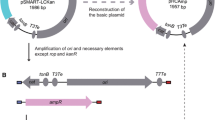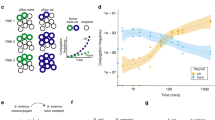Abstract
A plasmid, pGB112, has recently been developed to transfer DNA from Escherichia coli to Streptomyces spp via conjugation. This technique made use of (A) E. coli replicon, (B) ampicillin (amp) resistance gene for selection in E. coli and thiostrepton (tsr) resistance gene for selection in Streptomyces, (C) a fragment of SCP2* replicon, (D) a 2.6 kb fragment of tra-cassette which consists of pIJ101 transfer gene (tra) and two ermE promoters, (E) a 0.8 kb fragment of oriT of (IncP) RK2. The results showed that this plasmid was able to transfer plasmid DNA from E. coli to Streptomyces coelicolor via conjugation, and that it could also transfer DNA between Streptomyces strains. Since this plasmid has both pBR322 and SCP2* replicons, it may provide a novel and useful method for genetic operation in E.coli and Streptomyces.





Similar content being viewed by others
Change history
01 July 2006
Unfortunately, the authors were listed in the wrong order and there were errors in their affiliations. The corrected sequence and the correct affiliations are given below
References
Bierman M, Logan R, O’Brien K (1992) Plasmid cloning vectors for the conjugal transfer of DNA from Escherichia coli to Streptomycesspp. Gene 116:43–49
Deng ZX, Kieser T, Hopwood DA (1988) “Strong incompatibility” between derivatives of the Streptomyces multi-copy plasmid pIJ101. Mol Gen Genet 214:286–294
Dessel W, Mellaert L (2003) Improved PCR-based method for the direct screening of Streptomyces transformants. J Microbiol Methods 53:401–403
Donald G, Emanuel Y (1983) Location and nucleotide sequence of the transfer origin of the broad host range plasmid RK2. Proc Natl Acad Sci U S A 80:3595–3598
Gormley EP, Davies J (1991) Transfer of plasmid RSF1010 by conjugation from Escherichia coli to Streptomyces lividans and Mycobacterium smegmatis. J Bacteriol 173:6705–6708
Hopwood DA (1999) Forty years of genetics with Streptomyces: from in vivo through in vitro to in silico. Microbiology 145:2183–2202
Janssen GR, Bibb MJ (1990) Tandem promoters, tsrp1 and tsrp2, direct transcription of the thiostrepton resistance gene (tsr) of Streptomyces azureus: transcriptional initiation from tsrp2 occurs after deletion of the −35 region. Mol Gen Genet 221:339–346
Kendall KJ, Cohen SN (1987) Plasmid transfer in Streptomyces lividans: identification of a kil–kor system associated with the transfer region of pIJ101. J Bacteriol 169:4177–4183
Kendall KJ, Cohen SN (1988) Complete nucleotide sequence of the Streptomyces lividans plasmid pIJ101 and correlation of the sequence with genetic properties. J Bacteriol 70:634–651
Kieser T, Hopwood DA, Wright HM, Thompson CJ (1982) pIJ101, a multi-copy broad-range Streptomyces plasmid: functional analysis and development of DNA cloning vectors. Mol Gen Genet 185:223–238
Kieser T, Bibb Mervyn J, Buuner Mark J, Chater KF, Hopwood AD (2000) Genetic manipulation of Streptomyces. The John Innes Foundation, Norwich, United Kingdom
Larson JL, Hershberger CL (1986) The minimal replicon of a Streptomycete plasmid produces an ultrahigh level of plasmid DNA. Plasmid 15:199–209
Matsushima P, Cox KL, Baltz RH (1987) Highly transformable mutants of Streptomyces fradiae defective in several restriction systems. Mol Gen Genet 206:393–400
Mazodier P, Petter R, Thompson C (1989) Intergeneric conjugation between Escherichia coli and Streptomyces species. J Bacteriol 171:3583–3585
Sambrook J, Fritsh EF, Maniatis T (2000) Molecular cloning: a laboratory manual. Cold Spring Harbor Laboratory Press, New York
Zhihao Hu, Hopwood AD, Khosla C (2000) Directed transfer of large DNA fragments between Syreptomyces species. Appl Environ Microbiol 66:2274–2277
Acknowledgements
We thank Dr. Yang Ke-Qian for his kind advice, Prof. He Jian-Yong for his technological help, and Dr. C. J. Thompson for his useful suggestions on the project.
Author information
Authors and Affiliations
Corresponding author
Rights and permissions
About this article
Cite this article
Chen, X.Y., Mo, H.B., Liu, Y. et al. Development of a multifunctional and efficient conjugal plasmid for use in Streptomyces spp. Appl Microbiol Biotechnol 70, 705–710 (2006). https://doi.org/10.1007/s00253-006-0324-7
Received:
Revised:
Accepted:
Published:
Issue Date:
DOI: https://doi.org/10.1007/s00253-006-0324-7




